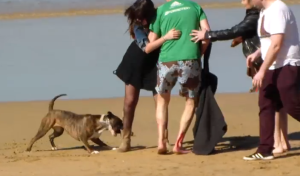Many dogs have problems when being around new people. This is most commonly seen within the dog’s own home, but it can occur in new locations as well. Similar to other types of dog aggression, stranger aggression is often rooted in some level of fear.

Fear of Strangers?
Yes, fear. Even some of the most strong reactions in a dog that look horribly aggressive can be rooted in fear or anxiety. Those displays are meant to keep the intruder away. This is particularly true when the intruder is on the home turf of the dog. If he doesn’t want you there, he will attempt to rid you from the area. In fact, many cases of stranger aggression at home also involve an element of territorial aggression. That means that the dog is territorial by nature (so more leery of strangers anyways), but then has a heightened worry about strangers. This will intensify how the dog feels.
These dogs often stand their ground with barking and growling, but if pushed on it, will often move back. For example, a young puppy of 5 months old might growl as fiercely as he can muster when a guest enters the home, but after a few moments if the person were to move slightly his way, he would likely step a few paces back or retreat entirely. When that same dog is an adult, he is better equipped to stand his ground and may or may not move away.
Most dogs that are simply territorial by nature can be easier to approach. If given treats when coming in or playing toys with them, they are more likely to be accepting of your presence and want to interact. Dogs with stranger aggression (and anxiety over your presence) remain much more vigilant and wary of that presence. Treats and playing with these dogs can improve the stranger’s likeability over time, but the dog takes a long time to warm up to the person, if it ever does.
Depth of Aggression
Can you bitten by a dog with a stranger aggression issue? Very much so. These dogs are normally of a stronger personality. By this it simply means that the dog is of a personality structure that is more decisive by nature and takes charge in a situation. Unfortunately, a take charge personality is not always a good thing in these situations as these dogs are more likely to bite.
Additionally, dogs with stranger aggression require more management and training. That’s because you need to be aware of the dog. These dogs can often learn to like one person, but then the whole process starts over again with a second person and so forth. They are generally not trustworthy around small children (other than your own), and great care should be taken with a dog like this in a household with children.
Away from Home
While stranger aggression is most common at home, this is partly because dogs with this issue have less access to the outside world due to their behavior. When they are taken to the outside world, caution must be taken. These dogs are likely to growl at people passing by and even attempt to lunge or nip at someone that walks near by.
In cases like this, consulting with a dog behavior expert is an excellent idea. There are behavior modification steps that have shown to be of great assistance in cases of dog aggression. In addition, environmental and diet changes can greatly improve aggressive reactions. These changes won’t entirely stop how your dog feels towards strangers, but they can dull his demeanor, which gives you more time to work on modifying his behavior.
Not only will you have to work on making him feel better about being around new people, he will also require a high level of obedience control. Commands like Leave It, Watch Me, Come, Sit, Down, and Stay are all essential commands that can help you in any situation that arises.
When initially working on training with a dog with stranger aggression, you have to keep his world safe (for others’ safety). That means you might start initial training by playing the people watching game. Try taking him to a location where you can just sit in the car and watch people go by. Continually pet him when he remains calm at seeing new people in the distance. Gradually you can move to sitting with the door open and even progress to a bench outside.
Don’t be afraid to keep people at bay! Especially if you have a small, cute dog, people will still want to interact with you or the dog. Let them know he isn’t ready for people to pet him or you may even have to get up and move away to keep the situation safe.
Final Note
While great progress can be made with behavior modification, there are some dogs that are difficult to alter for a variety of reasons (particularly if there is a genetic component or the dog is very unpredictable). Consult with a professional who can give you an honest assessment of your dog’s prognosis and the amount of time that will be required to work with him so that you can make a decision as to how best to proceed.
